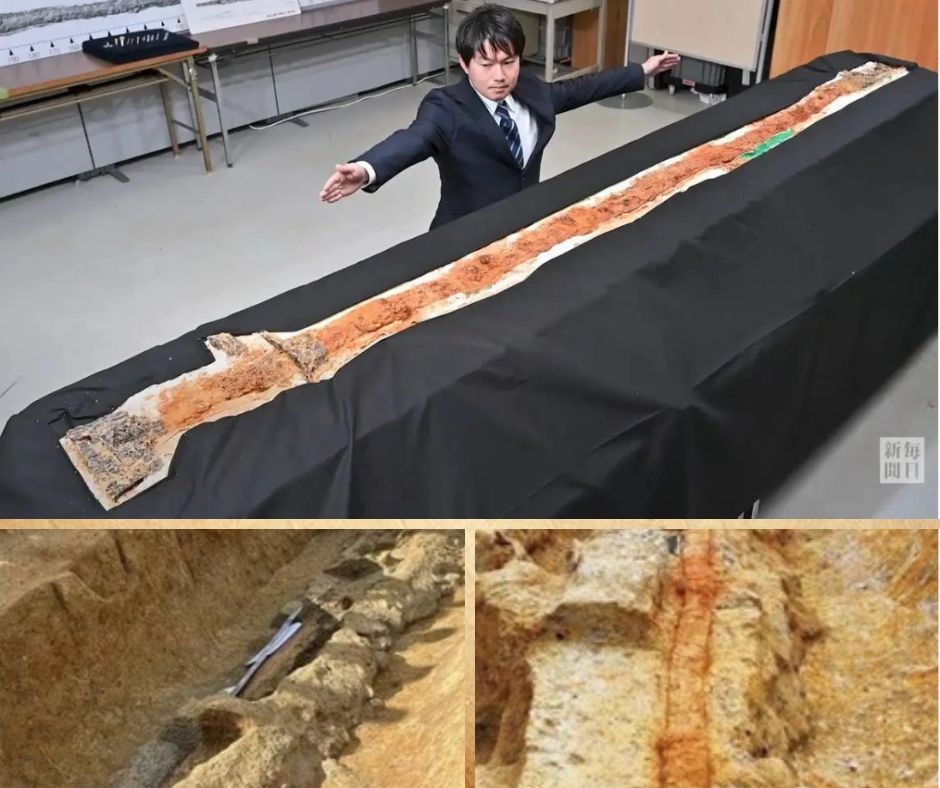KASHIHARA, Nara — Analysis of the humongous, snake-like “dako” iron sword excavated from Japan’s largest round burial mound in the city of Nara has revealed the blade having a never-before-seen “hybrid” design combining features of both a single-edged katana and a double-edged sword.

The Archaeological Institute of Kashihara, Nara Prefecture, and the Nara Municipal Board of Education announced the discovery on March 26. The unprecedented item is believed to be the origin of ceremonial blades created under the control of the Yamato Kingship.
This dako sword, measuring 2.37 meters long and 6 centimeters wide, is the oldest of its kind in Japan and the largest iron blade found in East Asia from the Kofun period (about third to seventh century). It was discovered in December 2022 along with a shield-shaped bronze mirror from an unlooted burial facility during an excavation survey conducted by the municipal education board at the Tomiomaruyama Kofun burial mound — dating from the late fourth century, and measuring 109 meters in diameter.
The archeological institute removed dirt attached to the surface of the sword during the preservation process using needles and other tools, and had carefully examined the item.
Sword mountings weren’t in their original forms at the time of the excavation, but were almost completely reconstructed via microscopic observation and non-destructive scientific analysis. It was found that the hybrid blade was bent six times, and in total measured 285 centimeters with the “tsuka” handle and the “saya” scabbard attached.
Its handle is approximately 38 centimeters long, and is entirely coated with black lacquer, except for the grip where the cloth and cord are wrapped. An L-shaped decoration called “kusabigata-tsukagashira,” commonly seen on katana, was found protruding from its tip. It is the oldest example of an iron katana with such a creative design, and the first ever sort of the decoration found on a double-edged sword. On the other hand, the hybrid blade also has a “tsukabuchi-tokki” protruding from the part that comes in contact with the scabbard — unique to double-edge swords.
First Kofun period blade to have protector
The hybrid blade’s scabbard is 2.48 meters long, made of Japanese bigleaf magnolia wood. It is cut to have an edge-grain surface, with black lacquer applied to the opening and the end of the scabbard and has a pattern on it similar to that of the L-shaped decoration. Attached to the end is protective gear for placing the sword on the ground called “ishizuki,” measuring 18.5 centimeters long. While such protectors have been found on spears and other weapons created down the line, it is the first to be found attached to a blade from the Kofun period.
During the Kofun period, there were single and double-edged swords, which, like the bronze mirror, were likely produced under the control of the Yamato Kingship and distributed based on one’s political background.
Masaki Kanekata, head of the archaeological institute, said the recent findings were “extremely surprising,” and “is an important source for clarifying the process behind the standardization of ceremonial swords by the Yamato Kingship.”
Naohiro Toyoshima, a professor of archaeology at Nara University who is knowledgeable about ancient swords, commented, “It is possible that the creative design of iron blades was being experimented with using this fourth-century dako sword. By the fifth century, the shapes of sword mountings began to diverge for single and double-edged swords, and this (dako sword) could have been the turning point.”
The giant dako sword is on public display at The Museum, Archaeological Institute of Kashihara, Nara Prefecture, until April 7.